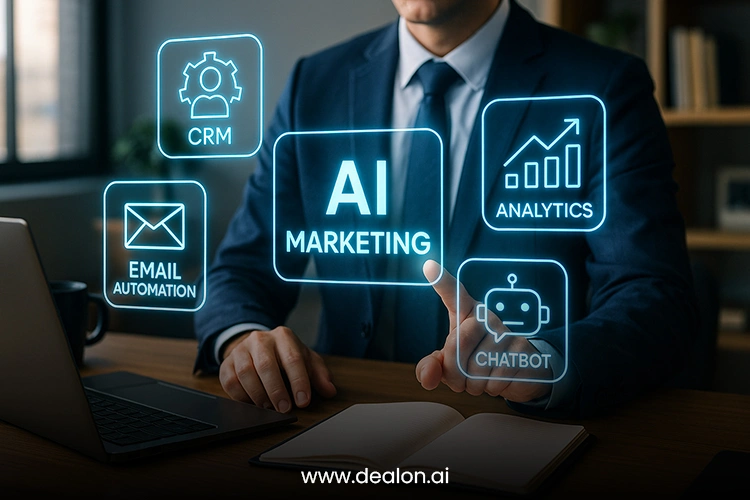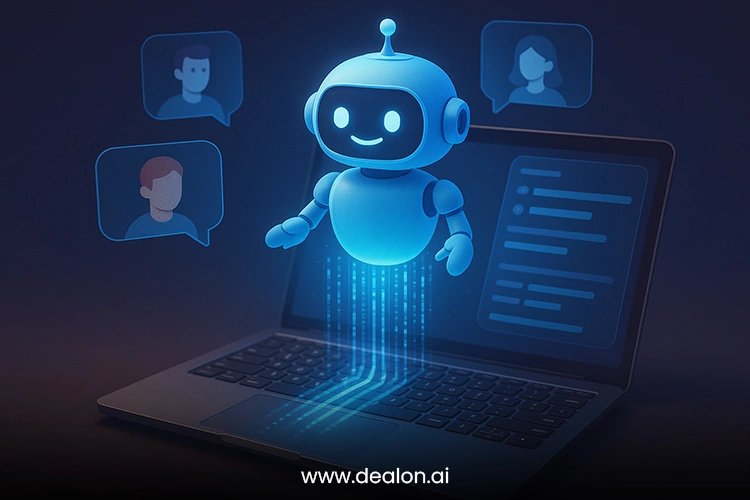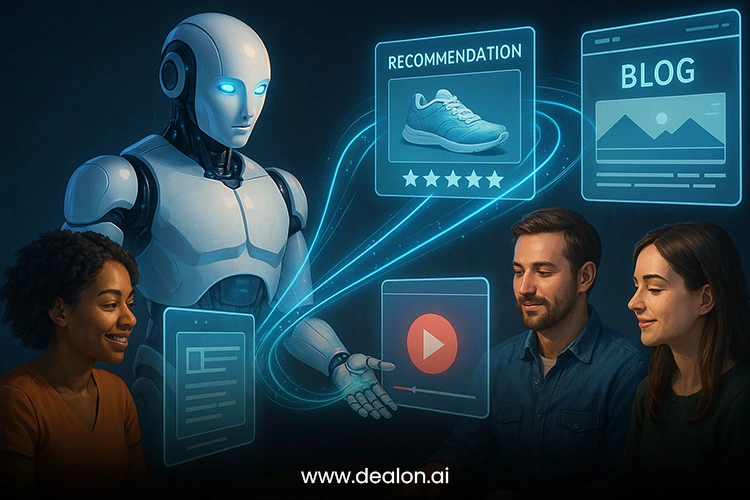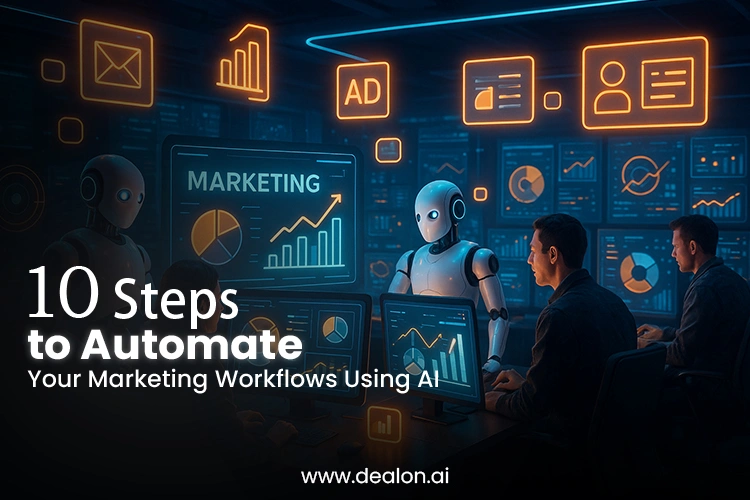Whether in the digital realm that is constantly changing or any other type of business, enterprises are continually looking to increase efficiency, minimize manual work, and improve customer interactions. The notion of including Artificial Intelligence (AI) in the process of marketing is among the most revolutionary propositions to have come across in recent times.
AI reduces the number of time-consuming activities that businesses process, therefore, allowing companies to concentrate on their strategic, influence-making projects and providing their customers with individualized and data-driven experiences. And be it by optimizing the email campaigns, personalizing the content, or making predictions on their customers’ behavior, AI can help simplify every part of the marketing process.
Beyond speed, AI gives power to process and analyze large volumes of data and reveals insights and patterns otherwise impossible to achieve. This information-loaded intelligence capitalizes on enabling businesses to make more informed and better decisions that lead to specific campaigns that appeal to their audience. At the same time, automation releases marketing teams from routine work, which enables them to concentrate on creativity and strategizing. Using AI, marketers will be able to make the experiences a lot more personalized, quicker, and at scale, which previously could only be achieved in a manual fashion, requiring significant resources.
Nonetheless, marketing automation by utilizing AI has to be premeditated. The mechanisms of including AI in your marketing strategy have to be clear to guarantee that it will work to its full extent. Whether it is automation of lead generation and segmentation, customer communication, and performance tracking, AI can streamline your entire marketing funnel. This blog post will look at 10 practical steps toward automating your marketing workflows with AI. They can lead you toward taking full advantage of the capabilities of AI to make your marketing more innovative and more efficient in 2025 and the years well beyond.
Also Read: Digital Therapist in Mental Health: Chatbots and AI In 2025
1. Analyze Your Marketing Requirement and Objectives

In initiating the automated process in your marketing workflows, the initial essential step is to review your current marketing processes. The given assessment contributes to the identification of areas where automation based on AI can bring the most value. Look into the places where your marketing operations are spending a lot of time and effort, whether creating content, customer segmenting, or lead nurturing. By recognizing such bottlenecks, you shall be in a position to know the areas where automation can support efficiency and productivity.
Besides, it is necessary to realize your overall marketing objectives. Depending on what you want to achieve, be it more leads, customer retention, or overall levels of engagement, each of these will need to be approached differently in terms of the application of AI. To give an example, say that the goal of your business is to increase lead generation, automation of initial contact points, chatbots, or lead capture forms, is of importance.
Another solution is that, in case you want to enhance customer interaction, AI can be used to develop personalized content and messaging strategies. However, by adjusting your AI tools to the particular goals, you can make sure that automation will be used strategically to reach the goals of your business, and the ROI will be maximized.
2. The Right AI Marketing Tools to Select

After determining what marketing needs you have, the next step is to ensure you identify the right AI marketing tools that will fit into what you seek. There are many options of platforms out there, so it is essential to select those solutions with the most significant relevance when it comes to automation. As an example, HubSpot, Marketo, and Active Campaign are the standard solutions that are used to automate email marketing campaigns as well as customer segmentation and personal messaging. These platforms can use AI to analyze the behavior of customers and their interactions with them, allowing a profound insight into how to perfect your marketing strategies.
Also, in selecting AI tools, it is essential to keep integration in mind. Your AI solutions must fit harmoniously into other systems that you already have, i.e., a customer relationship management tool or content management system. This also makes your marketing an integrated process, and all data between systems flows concretely. Another critical factor is scalability.
The demands of your marketing will change as your business develops. You should select such platforms that not only satisfy the current requirements but also can support growth in the future. An investment in a quality AI-powered tool will equip you with an efficient, automated marketing system that enables business long-term success.
3. With AI-Driven Chatbots, You Can Automate Lead Generation

Chatbots that AI drives have transformed the approach of businesses to leads. Such intelligent bots could greatly simplify the lead generation process because they communicate with real-time visitors of a website or social media users. Chatbots also lead to quick disqualification of bad leads, gathering of valuable information including contact details and preferences, and allocation of sales-ready leads to the sales team; all of this occurs immediately a visitor landed on your site.
Qualifying questions allow the AI chatbots to filter only those leads that might have real potential and forward them to the human agents. An example is asking a visitor his or her business needs or budget is an activity that a chatbot can conduct, to classify them accordingly to the sales team. Furthermore, chatbots can be integrated directly with CRM systems so that all the captured information is automatically updated, and, again, there is no need to enter it manually.
Follow-ups and outreach can also be made without complications using this integration and individualized outreach, depending on information that has been captured before, thus streamlining the whole process of lead nurturing. As the AI chatbots take a few initial steps of the lead generation process, your sales team can prioritize the leads and work with those that have a higher chance of becoming converted leads.
Additionally, the chatbots are available 24 hours a day, thus you can interact with potential customers around the clock, regardless of the time zone and working hours. This unlimited availability not only increases your chances of converting the leads but also helps in improving the customer experience by giving a real-time response.
4. Individualization of AI-Powered Content Delivery
The potential of using AI in marketing is also one of its most substantial advantages, as it allows delivering content to such an extent that it is personalized. The AI tools can monitor the customer behaviour, preferences, and interactions through multiple touch points, including web visits, social media indicators, and email metrics. Using such data, AI can present unique content that can impress the specific user, increasing the level of engagement and the conversion percentage.
Another example, AI can recommend a blog post, a video, or a product based on a user’s activity in visiting your site. In case one explores some of the products or reads some related content, the AI will suggest a similar experience based on the interests of the customer, making it all highly relevant and personal. Such a degree of customization not only enhances conversion but also builds trust and a strong association between your brand and the people, so that the customer will develop a feeling of being understood and appreciated.
Moreover, there is real-time personalization to the content that can be done with AI. AI can help make real-time suggestions or even messages as customers browse your websites or get your marketing emails. This implies that the content used will change depending on the actions of the users, and you will always feel that your communications are new and timely. More so, through AI-driven automation of the customization process, you can broaden your marketing intensity without compromising the personal touch that spurs engagement.
AI can also improve the timing and frequency of delivery of the content. Through predictive analytics, AI can know when a customer will most likely respond to a specific piece of content to deliver emails or posts to the customer at that time. This guarantees that you will have the right message communicated to the right people at the right time, thus increasing its effectiveness and impact.
5. Automate email marketing Campaigns
The traditional element of digital marketing, email marketing, and its prospects grow considerably once integrated with the use of AI-powered tools. Automation of email marketing campaigns will help a business to have a more experienced approach where each email will be targeted, personalized, and delivered at the right time to increase the efficiency of the customer as well as the business performance as a whole.
AI tools facilitate a high level of segmentation, with business companies being able to segregate their target market into different categories according to factors like behavior, buying habits, geographical location, or even familiarity levels with other past campaigns. This level of segmentation is much more accurate than the conventional ways of classification, which means every customer obtained content that addresses their own interests or previous relations. With the help of behavioral data, e.g., companies can now deliver product recommendations, special offers, or materials to those who find them most relevant to the target audience, creating a more interactive and individualistic experience.
Also, the time of delivering mail is improved with AI. Currently, AI tools are able to devise the optimal time of sending emails to individual customers by studying open rates in the past, to ensure the email arrives at the inbox when the recipients are most likely to be interested. This methodology will help you avoid any guesswork and increase the possibility of your emails being opened and read.
Moreover, AI can be used to automate follow-up emails to make sure that they are delivered at the opportune moment to keep engagement and initiate action on the recipient. Such an automation enhances efficiency, mitigates manual work, and enables businesses to ensure continuity of outreach, which eventually results in improved open rates, click-through rates, and conversions.
6. Improve Performance Using Predictive Analytics
Through the use of historical data, behavioral information, and advanced algorithms, AI is capable of predicting future customer behavior, which gives companies the chance to optimize their plans and target the most rewarding opportunities. The AI tools look at the historical data on how you engaged with that brand before, either through browsing history, previous purchases, or interacting with past campaigns, and estimate the likelihood of a customer buying your product.
By way of example, depending on past actions, AI can select those leads who are most likely to purchase or subscribe to their services. This will help you have high-value prospects so that your marketing resources are focused only on those with a high probability of getting results.
Predictive analytics is also helpful in streamlining the message and content of your campaigns. Understanding trends when they react to different types of content, AI can propose the best viable method to be used in further communication. Furthermore, marketers can do real-time strategy modifications to enhance performance as AI can forecast the performance of particular campaigns.
As another example, when the data indicates that specific offers have a higher tendency to convert during certain days and/or at certain times, the marketing team could schedule their campaigns accordingly. Through predictive analytics, companies will be able to make reasonable decisions, increase targeting, and, in the end, increase their ROI.
7. Automated Social Media posting and scheduling of content
Social media is an essential element in the current marketing strategies, and maintaining multiple accounts, regular content uploads, and user interaction on various platforms may prove too much. Here is where AI-assisted tools such as Buffer or Hootsuite enter the picture because they give an intelligent way to manage social media more conveniently.
By examining behaviour and patterns of engagement by the audience on various platforms, AI tools have the capability of scheduling and posting content and updates on social media, freeing up time. These tools enable the marketer to scan when to post material about the activity of their followers so that their material is picked up by the maximum number of people at the required time. This ability enables the business to schedule posts ahead of time and needs little manual input, while keeping them in check regularly and on time.
Also, AI has the potential to monitor how consumers interact with your social media posts, giving you real-time information as to which category of content is most likely to generate the most interest among your audience. The review of the interaction, like likes, shares, comments, and clicks, could suggest changes to the content strategy and ensure a company keeps optimizing its approach.
To put it into perspective, when a particular type of post (video content, product demonstrations) proves to be more engaging than others, the AI robot can propose to include more posts of this kind in the subsequent runs. This circular process of data-driven feedback assisted the businesses to be on the edge of trends, improve the focus on the content strategy, and engage their audience.
8. Engage AI-Driven Customer Segmentation
Customer segmentation is an excellent method of establishing personalized marketing campaigns that appeal to particular customer groups. AI has brought a revolution to the business concept of segmentation, making the process highly granular and dynamic with a broad scope of attributes, including much more than demographic information, buying history, browsing history, and even social media interactions.
As opposed to the traditional segmentation, which makes significant assumptions and generalizations, AI-driven segmentation is based on real-time information and machine learning algorithm-based segmentation to help categorize customers better. This allows businesses to have more tailored marketing plans that reach out directly to the needs and preferences of each segment. As an example, the customers that recently demonstrated interest in a particular product or category may be coupled in a way that enables a hyper-targeted promotion, recommendation, or follow-up content to take place.
Another advantage of AI is that it enables companies to keep improving their segmentation with the inflow of new information. As the customer and their interactions are tracked at various touchpoints, the AI tools may dynamically optimize the segmentation models, thus making sure that the market message will be relevant to the specific individual. With the changing preferences of customers as time moves on, AI helps in keeping segmentation up to date, thus contributing to the personalization of content delivery and the ultimate customer experience. Such perpetual adaptation is a necessity to ensure productive relationships with clients and to motivate a long-term engagement.
9. Make use of AI to optimize Ad Campaigns
AI is transforming the sphere of digital advertising by offering automated functions that require human labor in the process of targeting their advertisements, bids, and general campaign optimization. New kinds of advertising media, such as Google Ads and Facebook Ads, introduced AI algorithms that improve the accuracy of your advertising efforts. Such platforms have AI that automatically optimizes bids to target an audience at the most convenient time. Rather than making sequential allocations, AI is used to dynamically manage budget and bidding by analyzing customer behaviors, interests, and engagement patterns to maximize viewability in ads.
AI not only optimizes bids but also continuously monitors the ad performance in real-time. This enables immediate adjustments to be made based on measures of performance, click-through rate, conversion, or level of engagement. In cases where an ad is appearing with more success with less than optimal bidding, AI will automatically bid more or transfer funds to that segment to maximize the possible impact on that segment.
Automation of these processes also results in time-saving and provides businesses with greater efficiency of ad spend, thus enhancing the return on investment (ROI) significantly. What is more, AI can also determine which of the ads are not performing well enough and adjust them automatically so they can reach preset KPIs and not spend money in vain, instead maximizing the effectiveness of ad campaigns.
10. Track and analyse the performance of campaigns with AI Analytics
AI analytics is now a necessity to be used in measuring and optimizing the effectiveness of marketing campaigns. Using giant sets of customer data, AI will offer practical insights into how well you are doing and bring out the leading performance indicators, such as engagement rates, conversion rates, and customer acquisition costs. These analytics devices are more than mere reporting tools since they provide predictive data that helps predict future trends and behaviors.
All performance-related reports could be provided automatically in great detail thanks to AI tools, which contribute to finding effective strategies and highlight where improvements should be made. The on-the-fly adjustments are also possible, as the ability to create the campaign in real-time means that the business can improve over time. Companies can make better decisions using data, guaranteeing the further development and improvement of marketing processes, which will increase conversion rates and ROI.
Conclusion
The trend to integrate automation into marketing processes with the help of AI is changing the way marketing activities are conducted since it allows companies to automate the most routine tasks, increase personalization, and operate more conveniently and efficiently. Whether it is automating the generation of leads using AI-based chatbots, optimizing an ad campaign, or measuring the performance of such campaigns, AI is a handy tool, making less work with more results.
The first way you can make use of AI in marketing is to ensure you target your audience and streamline ROI through enhanced customer engagement. Going through automated email campaigns, improving customer segmentation, and using predictive analytics, AI gives the basis for clever marketing based on data. By adopting such AI tools, businesses will now have an upper hand in the competitive, fast-paced digital world.

